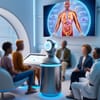In a groundbreaking development, AI-powered chatbots have demonstrated an unprecedented ability to diagnose illnesses, outperforming human doctors in the process. This remarkable achievement has the potential to revolutionize the healthcare industry, providing patients with faster, more accurate, and more accessible diagnoses.
A recent study pitted AI chatbots against human doctors in a diagnostic challenge. The results were astounding: the AI chatbots emerged victorious, accurately diagnosing illnesses with a higher degree of precision than their human counterparts. This landmark study marks a significant milestone in the development of AI-driven healthcare solutions.
So, what sets AI chatbots apart from human doctors? The answer lies in their unique combination of speed, accuracy, and accessibility. AI chatbots can process vast amounts of medical data in mere seconds, identifying patterns and connections that might elude human doctors. Moreover, AI chatbots are available 24/7, providing patients with instant access to medical expertise, regardless of their geographical location or financial means.
While AI chatbots have demonstrated an impressive ability to diagnose illnesses, it's essential to recognize that they are not a replacement for human doctors. Instead, AI chatbots should be seen as a valuable tool that can augment and support human medical expertise. By combining the strengths of both humans and AI, we can create a more efficient, effective, and patient-centric healthcare system.
As AI chatbots continue to evolve and improve, we can expect to see significant advancements in the field of healthcare. However, there are also challenges to be addressed, such as ensuring the accuracy and reliability of AI-driven diagnoses, protecting patient data and privacy, and mitigating the risk of job displacement for human healthcare professionals.
In conclusion, the emergence of AI chatbots as a diagnostic tool marks a significant turning point in the history of healthcare. As we move forward, it's essential that we prioritize collaboration between humans and AI, leveraging the strengths of both to create a more compa


